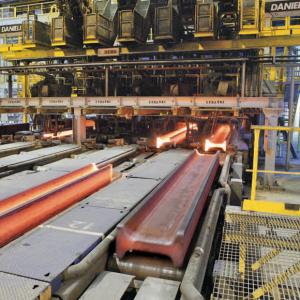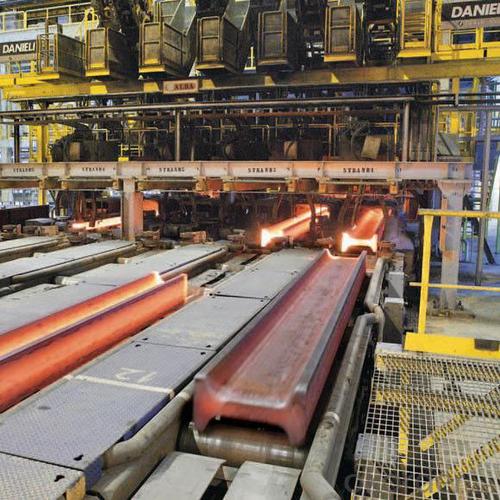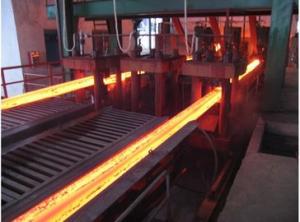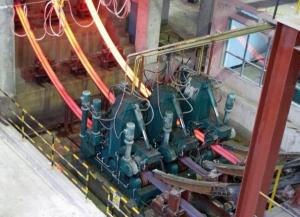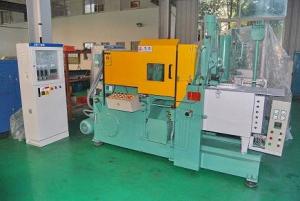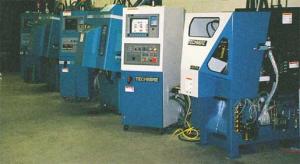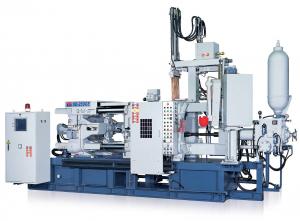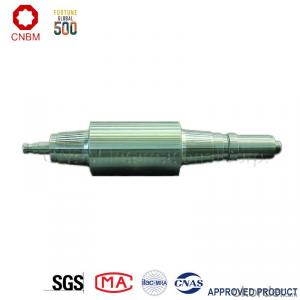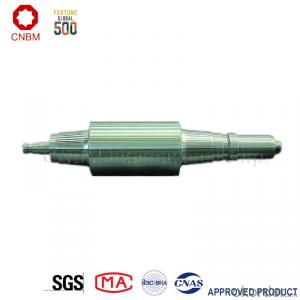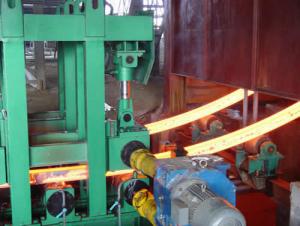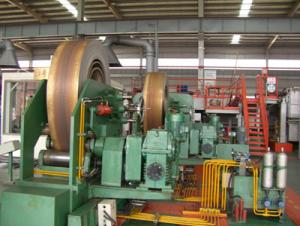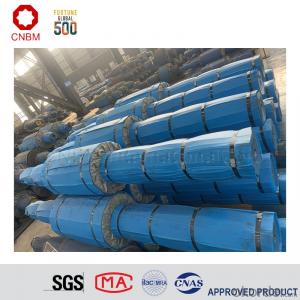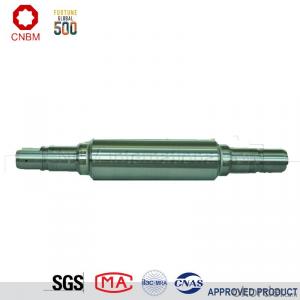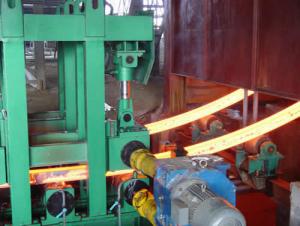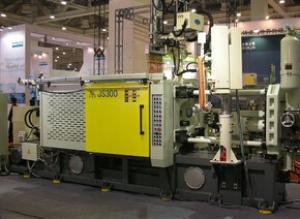Continuous Casting Machine (R4M 3-Strand)
- Loading Port:
- China Main Port
- Payment Terms:
- TT or LC
- Min Order Qty:
- 1 Set set
- Supply Capability:
- 20 Sets Per Year set/month
OKorder Service Pledge
Quality Product, Order Online Tracking, Timely Delivery
OKorder Financial Service
Credit Rating, Credit Services, Credit Purchasing
You Might Also Like
Technology process:
1.Heat the EVA film
2.Cover the heated EVA film on the mould(can be made from wood or aluminum)
3.Spray a coating in a certain baume degree
4.Put on the empty blask
5.Sand-up the flask and vibrate to compaction
Packaging & Delivery
Packaging Details:containers
Delivery Detail:Complete one set of equipment needs for three months
- Q: How is the molten metal poured into the mold using metal casting machinery?
- In metal casting machinery, the process of pouring molten metal into the mold is known as casting. This process involves several steps to ensure accuracy and precision in creating the desired metal object. Firstly, the mold is prepared by creating a cavity in the shape of the desired object. The mold can be made from various materials such as sand, ceramic, or metal, depending on the type of metal being cast and the complexity of the object. Once the mold is ready, it is securely placed in the casting machinery. The machinery consists of a crucible, which is a container that holds the molten metal. The crucible is typically made from a material with high melting point and good thermal conductivity, such as graphite or ceramic. The metal is heated in a separate furnace until it reaches its melting point. Once molten, the metal is transferred to the crucible in the casting machinery. This can be done manually or using automated systems, depending on the scale and complexity of the casting process. Once the molten metal is in the crucible, it is ready to be poured into the mold. This is done by tilting or rotating the crucible, allowing the molten metal to flow out and into the mold cavity. The pouring mechanism in the machinery ensures controlled and precise pouring to avoid any spillage or defects in the final product. During the pouring process, it is crucial to maintain the temperature of the molten metal to prevent premature solidification or cooling. This can be achieved by using insulating materials around the mold and employing heating elements if necessary. After the molten metal is poured into the mold, it is left to cool and solidify. The cooling time depends on the type and thickness of the metal being cast. Once solidified, the mold is removed, and the metal object is extracted. Overall, the process of pouring molten metal into the mold using metal casting machinery involves precise control of temperature, pouring mechanism, and mold preparation. This ensures that the final product meets the required specifications and quality standards.
- Q: Can metal casting machinery be used for the production of medical implants?
- Yes, metal casting machinery can be used for the production of medical implants. Metal casting is a manufacturing process that involves pouring molten metal into a mold to create a desired shape. This process can be used to produce various types of medical implants, such as hip and knee replacements, dental implants, and bone fixation devices. The use of metal casting machinery in the production of medical implants offers several advantages. Firstly, it allows for the production of complex and intricate shapes that are often required for implants. The flexibility of metal casting machinery enables the creation of implants with precise dimensions and intricate geometries, ensuring a more accurate fit and better patient outcomes. Secondly, metal casting allows for the use of different types of metals and alloys, such as stainless steel, titanium, and cobalt-chromium. These materials offer excellent biocompatibility, corrosion resistance, and mechanical strength, making them ideal for medical implants. Metal casting machinery enables the precise control of the casting process, ensuring the production of high-quality and consistent implants. Additionally, metal casting machinery allows for cost-effective mass production of medical implants. The use of molds and the ability to pour molten metal into multiple molds simultaneously increases the production rate, reducing manufacturing costs. This is especially important in the healthcare industry, where there is a growing demand for medical implants due to the aging population and advancements in medical technology. In conclusion, metal casting machinery can be effectively utilized for the production of medical implants. Its ability to produce complex shapes, use different materials, and facilitate cost-effective mass production makes it a valuable manufacturing process in the medical industry.
- Q: What are the different types of warranties and support services provided by manufacturers of metal casting machinery?
- Various types of warranties and support services are typically offered by manufacturers of metal casting machinery in order to guarantee customer satisfaction and product performance. The specific warranties and support services can differ depending on the manufacturer and the particular product being purchased. Here are several commonly provided types: 1. Standard Product Warranty: Most manufacturers provide a standard product warranty that covers defects in materials or workmanship for a specified period. This warranty ensures that the manufacturer will repair or replace the machinery free of charge if any issues arise during normal use. 2. Extended Warranty Option: In addition to the standard warranty, some manufacturers give customers the choice to purchase an extended warranty, which extends the coverage period beyond the standard warranty. This offers customers extra protection and peace of mind for a longer duration. 3. Technical Assistance: Manufacturers often have technical support teams that can offer guidance and assistance with the installation, operation, and maintenance of the metal casting machinery. This support can be accessed through phone, email, or online chat, and helps customers troubleshoot any problems they may encounter. 4. Availability of Spare Parts: Manufacturers typically keep an inventory of spare parts for their machinery. This ensures that customers can easily obtain the necessary parts in case of breakdowns or wear and tear. Manufacturers may also provide expedited shipping services for spare parts to minimize downtime. 5. On-Site Assistance: Some manufacturers offer on-site support services, where their technicians visit the customer's facility to provide hands-on assistance with installation, calibration, and troubleshooting. This type of support is particularly beneficial for larger and more complex metal casting machinery. 6. Training Programs: To ensure that customers can effectively operate and maintain their metal casting machinery, manufacturers often offer training programs. These programs can be conducted either at the manufacturer's facility or on-site at the customer's location. They aim to educate operators and maintenance personnel on the proper usage, safety protocols, and routine maintenance of the machinery. 7. Upgrades and Software Updates: Manufacturers may periodically release upgrades and software updates for their metal casting machinery to enhance its performance, capabilities, or address any known issues. These updates may be provided free of charge or at a discounted price for existing customers. In summary, manufacturers of metal casting machinery provide warranties and support services to ensure that customers receive a high-quality product and have the necessary assistance to optimize its performance, reliability, and longevity. It is important to review the specific terms and conditions of the warranties and support services offered by each manufacturer to fully understand the extent of coverage and support provided.
- Q: What are the different types of production optimization techniques used in metal casting machinery?
- There are several types of production optimization techniques used in metal casting machinery. Some of the commonly employed techniques include process automation, statistical process control, lean manufacturing, Six Sigma, and computer-aided engineering. These techniques aim to enhance productivity, improve quality, reduce waste, minimize defects, and optimize the overall production process in metal casting machinery.
- Q: Can metal casting machinery be used for investment casting of zinc alloys?
- Yes, metal casting machinery can be used for investment casting of zinc alloys. Investment casting, also known as lost-wax casting, is a process that involves creating a wax pattern, covering it in a ceramic shell, and then melting the wax out to create a cavity. The molten metal is then poured into the cavity to form the desired shape. Metal casting machinery can be used for this process by utilizing various equipment such as furnaces, crucibles, and molds. The machinery is capable of melting the zinc alloy to the required temperature and pouring it into the ceramic shell to create the final product. However, it is important to note that the specific machinery used for investment casting of zinc alloys may have certain requirements or modifications to ensure the optimal casting process. For example, the machinery may need to have the ability to control the temperature accurately to prevent overheating or inadequate melting of the zinc alloy. Additionally, the machinery used for investment casting of zinc alloys should have the capability to handle the specific characteristics of zinc, such as its low melting point and high fluidity. This may require adjustments to the casting process, such as altering the mold design or using different cooling techniques, to achieve the desired results. Overall, metal casting machinery can be used for investment casting of zinc alloys, but it may require specific modifications or considerations to ensure successful casting of the zinc alloy.
- Q: How does metal casting machinery handle the removal of vents from castings?
- Metal casting machinery typically handles the removal of vents from castings through a process known as venting or shaking out. This process is crucial to ensure the quality and integrity of the final casting. After the molten metal is poured into the mold, it begins to solidify. During this solidification process, gases and air pockets can become trapped within the metal. These trapped gases can cause defects in the casting, such as porosity or air bubbles, which can compromise its strength and structural integrity. To remove these trapped gases, vents are designed and incorporated into the mold. Vents are small channels or passages that allow the gases to escape as the metal solidifies. These vents are typically placed strategically in areas where gas is likely to be trapped, such as corners or complex geometries. Once the casting has cooled and solidified, the metal casting machinery is used to remove the vents from the casting. This is typically done by vibrating or shaking the casting, causing the sand or other mold materials to break away from the casting and exposing the vents. The shaking or vibrating action dislodges the sand particles and other mold materials that surround the casting, allowing the vents to be easily removed. This process is carefully controlled to prevent damage to the casting itself. After the removal of vents, the casting is inspected for any remaining sand particles or debris. This is done to ensure that the casting is clean and free from any contaminants that could affect its quality or performance. In summary, metal casting machinery handles the removal of vents from castings through a shaking or vibrating process. This removes the sand and other mold materials surrounding the casting, allowing the vents to be exposed and removed. This process is essential to eliminate trapped gases and ensure the quality and integrity of the final casting.
- Q: What is the role of artificial intelligence (AI) in metal casting machinery?
- The purpose of artificial intelligence (AI) in metal casting machinery is to enhance the casting process by improving efficiency, accuracy, and productivity. Metal casting machinery incorporates AI technologies to automate tasks and optimize overall operations. AI plays a crucial role in process control and optimization within metal casting machinery. By analyzing data from sensors and monitoring systems, AI algorithms can make real-time adjustments to casting parameters. This results in improved casting quality, reduced defects, and minimized material waste. AI can also predict and prevent potential issues such as temperature variations, mold erosion, or casting cracks, allowing for proactive maintenance and improved performance. Furthermore, AI in metal casting machinery optimizes production planning and scheduling. By analyzing historical data and considering factors like demand, material availability, and machine capacities, AI algorithms generate optimized production plans that maximize efficiency and minimize downtime. This leads to better resource utilization, cost reduction, and meeting delivery deadlines. In addition, AI technologies enhance the predictive maintenance capabilities of metal casting machinery. Through continuous monitoring of various components and systems, AI algorithms detect early signs of potential failures or malfunctions. This enables timely maintenance and reduces the risk of unexpected breakdowns, resulting in increased machine uptime and reduced maintenance costs. Moreover, AI improves the automation and integration of robotics in metal casting machinery. By utilizing computer vision and machine learning algorithms, AI enables intelligent robotic systems to handle complex tasks such as mold manipulation, pouring, and post-processing. This not only improves efficiency but also ensures worker safety by reducing exposure to hazardous environments. Overall, AI optimizes the casting process, improves production planning, enhances predictive maintenance, and enables intelligent automation in metal casting machinery. Harnessing the power of AI allows metal casting manufacturers to achieve higher productivity, improved quality, and reduced costs, ultimately gaining a competitive advantage in the industry.
- Q: How is the casting tested for non-destructive evaluation in metal casting machinery?
- Non-destructive evaluation techniques are commonly employed to test the casting quality in metal casting machinery. These techniques include visual inspection, ultrasonic testing, magnetic particle inspection, liquid penetrant testing, and radiographic testing. Each method has its own advantages and limitations, but together they provide a comprehensive assessment of the casting's integrity without causing any damage to the final product.
- Q: What are the different types of shakeout and cleaning processes used with metal casting machinery?
- Metal casting machinery utilizes various shakeout and cleaning processes, each designed for specific purposes in eliminating excess material and impurities from the castings. Several commonly used processes are as follows: 1. Mechanical Shakeout: Employing mechanical vibrations or shaking movements, this process effectively eliminates sand, mold material, and other debris from the castings. Specialized shakeout machines capable of handling large casting volumes typically carry out this process. 2. Thermal Shakeout: By subjecting the castings to high temperatures, this process causes the burning off of sand and other materials. A dedicated furnace or oven known as a shakeout furnace is often utilized to aid in the removal of stubborn sand and mold materials. 3. Shot Blasting: Shot blasting involves propelling small metal shots at high speeds onto the castings. This technique eradicates surface contaminants like rust, scale, and sand, providing a clean and smooth surface finish. Shot blasting is commonly employed for metal castings requiring a high-quality surface finish. 4. Sand Blasting: Similar to shot blasting, sand blasting employs small sand particles instead of metal shots to cleanse the castings. It effectively removes paint, coatings, and other surface contaminants. Sand blasting is often utilized for castings that need preparation for subsequent processes like painting or coating. 5. Chemical Cleaning: Chemical cleaning processes employ chemicals to dissolve or loosen contaminants from the castings. Acid solutions, alkaline solutions, or specialized cleaning agents may be utilized. Chemical cleaning is often preferred for delicate castings or those with complex geometries that are difficult to clean mechanically. 6. Ultrasonic Cleaning: Ultrasonic cleaning utilizes high-frequency sound waves to create microscopic bubbles in a liquid cleaning solution. The implosion of these bubbles generates a scrubbing action, aiding in the removal of dirt, grease, and other contaminants from the castings. Ultrasonic cleaning proves effective for small and intricate castings that may be challenging to clean using alternative methods. Ultimately, the selection of shakeout and cleaning processes is dependent on factors such as casting size and complexity, desired surface finish, and the type of contaminants present. Manufacturers frequently employ a combination of these processes to ensure the utmost quality and cleanliness of their metal castings.
- Q: How is the porosity of castings controlled with metal casting machinery?
- The control of porosity in castings can be achieved through various techniques and process parameters using metal casting machinery. The quality and characteristics of the mold used in the casting process are one of the primary factors that affect porosity. It is important for the mold material to have good permeability and venting properties, allowing gases to escape during the solidification of the metal. In addition, the design of the gating system and the placement of risers are crucial in controlling porosity. The gating system helps direct the flow of molten metal into the mold, while the risers act as reservoirs to feed the molten metal as it solidifies. Proper design of the gating system and risers enables a smooth and controlled flow of metal, minimizing turbulence and the entrapment of gases. Controlling the temperature of the mold is another critical factor in preventing porosity. Maintaining the appropriate mold temperature ensures proper solidification and reduces the likelihood of hot spots or cold shuts that can lead to porosity. This can be achieved by using cooling channels or by controlling the temperature of the mold material itself. Furthermore, the selection and control of casting process parameters, such as pouring temperature, pouring speed, and solidification time, are essential in controlling porosity. Monitoring the pouring temperature prevents excessive turbulence and gas entrapment, while controlling the pouring speed ensures a smooth flow of metal. Optimizing the solidification time allows for the escape of gases and complete filling of the mold cavity. Lastly, the use of various additives and alloys can also aid in controlling porosity. Grain refiners, for example, can promote a finer grain structure, reducing the likelihood of porosity. Degassing agents can remove dissolved gases from the molten metal, minimizing the potential for gas porosity. In conclusion, controlling porosity in castings with metal casting machinery involves a combination of factors, including mold quality, gating system design, mold temperature control, casting process parameters, and the use of additives and alloys. By carefully considering and optimizing these factors, manufacturers can achieve castings with minimal porosity and improved quality.
Our professions include metallurgical technology, equipment and automation. We can provide the best solutions to the production process, design & manufacture of equipment and electrical automation regarding various industries in domestic and foreign districts with exquisite technology and fine quality service. We can provide all-around services to customers from development & design to the provision, installation and running of products.Strong technical strength, advanced equipment manufacturing technology, fine quality professional talents, and perfect service systems all bring about reliability, relaxation, convenience and delight to the cooperation with customers from beginning to end.
1. Manufacturer Overview
| Location | Jiangsu,China (Mainland) |
| Year Established | 2000 |
| Annual Output Value | |
| Main Markets | South America Eastern Europe Southeast Asia Africa Mid East South Asia Domestic Market |
| Company Certifications |
2. Manufacturer Certificates
| a) Certification Name | |
| Range | |
| Reference | |
| Validity Period |
3. Manufacturer Capability
| a) Trade Capacity | |
| Nearest Port | SHANGHAI |
| Export Percentage | 21% - 30% |
| No.of Employees in Trade Department | 3-5 People |
| Language Spoken: | English, Chinese |
| b) Factory Information | |
| Factory Size: | |
| No. of Production Lines | |
| Contract Manufacturing | |
| Product Price Range | |
Send your message to us
Continuous Casting Machine (R4M 3-Strand)
- Loading Port:
- China Main Port
- Payment Terms:
- TT or LC
- Min Order Qty:
- 1 Set set
- Supply Capability:
- 20 Sets Per Year set/month
OKorder Service Pledge
Quality Product, Order Online Tracking, Timely Delivery
OKorder Financial Service
Credit Rating, Credit Services, Credit Purchasing
Similar products
Hot products
Hot Searches
